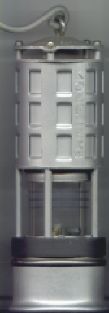Safety lamp
Safety lamp is a type of lamp designed to provide illumination in environments where the presence of flammable gases such as methane or combustible dusts could lead to a fire or explosion if ignited. The development of safety lamps was primarily driven by the need to improve the safety of coal mining operations in the early 19th century. Before the invention of the safety lamp, miners used open-flame lamps for illumination, which frequently caused catastrophic mine explosions.
History[edit | edit source]
The history of the safety lamp is closely associated with the figure of Sir Humphry Davy, a British chemist and inventor, who, in 1815, introduced the first safety lamp that could be safely used in flammable atmospheres. Davy's lamp worked by enclosing the flame in a mesh screen which cooled the flame and prevented the ignition of methane gas outside the lamp. Almost simultaneously, George Stephenson, an engineer and inventor, developed his own version of the safety lamp, known as the Geordie lamp. Despite controversies over priority, both lamps significantly reduced the number of explosions in coal mines, saving countless lives.
Design and Function[edit | edit source]
The key feature of a safety lamp is its ability to provide light without igniting the surrounding atmosphere. This is achieved through various means: - Davy Lamp: Utilizes a fine mesh screen which surrounds the flame. The mesh acts as a flame arrestor; gases can pass through and be ignited inside the mesh, but the flame cannot propagate back through the mesh to the external atmosphere. - Mueseler Lamp: Introduced by Belgian engineer Mathieu Mueseler in 1840, this lamp includes a central air draft tube which improves the cooling of the mesh and reduces the likelihood of igniting gases. - Electric Safety Lamps: With the advent of electrical technology, battery-powered lamps became prevalent, eliminating the flame source entirely and significantly reducing the risk of ignition.
Usage[edit | edit source]
While initially developed for coal mining, the principles of the safety lamp have been applied in various industries where explosive gases are a concern, including the oil and gas industry, grain storage, and certain chemical manufacturing processes.
Legacy[edit | edit source]
The invention of the safety lamp marked a significant advancement in industrial safety, highlighting the importance of scientific contributions to occupational health and safety. It also paved the way for further research into the properties of gases and the development of more advanced safety equipment.
See Also[edit | edit source]
Search WikiMD
Ad.Tired of being Overweight? Try W8MD's physician weight loss program.
Semaglutide (Ozempic / Wegovy and Tirzepatide (Mounjaro / Zepbound) available.
Advertise on WikiMD
|
WikiMD's Wellness Encyclopedia |
| Let Food Be Thy Medicine Medicine Thy Food - Hippocrates |
Translate this page: - East Asian
中文,
日本,
한국어,
South Asian
हिन्दी,
தமிழ்,
తెలుగు,
Urdu,
ಕನ್ನಡ,
Southeast Asian
Indonesian,
Vietnamese,
Thai,
မြန်မာဘာသာ,
বাংলা
European
español,
Deutsch,
français,
Greek,
português do Brasil,
polski,
română,
русский,
Nederlands,
norsk,
svenska,
suomi,
Italian
Middle Eastern & African
عربى,
Turkish,
Persian,
Hebrew,
Afrikaans,
isiZulu,
Kiswahili,
Other
Bulgarian,
Hungarian,
Czech,
Swedish,
മലയാളം,
मराठी,
ਪੰਜਾਬੀ,
ગુજરાતી,
Portuguese,
Ukrainian
Medical Disclaimer: WikiMD is not a substitute for professional medical advice. The information on WikiMD is provided as an information resource only, may be incorrect, outdated or misleading, and is not to be used or relied on for any diagnostic or treatment purposes. Please consult your health care provider before making any healthcare decisions or for guidance about a specific medical condition. WikiMD expressly disclaims responsibility, and shall have no liability, for any damages, loss, injury, or liability whatsoever suffered as a result of your reliance on the information contained in this site. By visiting this site you agree to the foregoing terms and conditions, which may from time to time be changed or supplemented by WikiMD. If you do not agree to the foregoing terms and conditions, you should not enter or use this site. See full disclaimer.
Credits:Most images are courtesy of Wikimedia commons, and templates, categories Wikipedia, licensed under CC BY SA or similar.
Contributors: Prab R. Tumpati, MD






